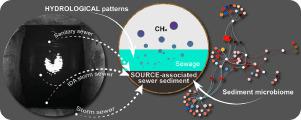Water Research ( IF 11.4 ) Pub Date : 2020-11-26 , DOI: 10.1016/j.watres.2020.116670 Hao Chen , Zhongning Wang , Hui Liu , Yunhan Nie , Yi Zhu , Qilong Jia , Guoping Ding , Jianfeng Ye

|
Production of methane (CH4), an essential anthropogenic greenhouse gas, from municipal sewer sediment is a problem deserving intensive attention. Based on long-term laboratory batch tests in conjunction with 16 s rRNA gene sequencing and metagenomics, this study provides the first detailed assessment of the variable sediment CH4 production in response to different pollution source-associated sewer sediment types and hydrological patterns, while addressing the role of the sediment microbiome. The high CH4-production capability of sanitary sewer sediment is shaped by enriched biologically active substrate and dominated by acetoclastic methanogenesis (genus Methanosaeta). Moreover, it involves syntrophic interactions among fermentation bacteria, hydrogen-producing acetogens and methanogens. Distinct source-associated microbial species, denitrifying bacteria and sulfate-reducing bacteria occur in storm sewer and illicit discharge-associated (IDA) storm sewer sediments. This reveals their insufficient microbial function capabilities to support efficient methanogenesis. Hydrogenotrophic methanogenesis (genus Methanobacterium) prevails in both these sediments. In this context, storm sewer sediment has an extremely low CH4-production capability, while IDA storm sewer sediment still shows significant carbon emission through a possibly unique mechanism. Hydrological connections promote the sewer sediment biodegradability and CH4-production capability. In contrast, hydrological disconnection facilitates the prevalence of acetoclastic methanogenesis, sulfate-reducing enzymes, denitrification enzymes and the sulfur-utilizing chemolithoautotrophic denitrifier, which drastically decreases CH4 production. Turbulent suspension of sediments results in relative stagnation of methanogenesis. This work bridges the knowledge gap and will help to stimulate and guide the resolution of ‘bottom-up’ system-scale carbon budgets and GHG sources, as well as the target CH4 abatement interventions.
中文翻译:

响应于与源相关的不同下水道沉积物类型和水文模式的变化,产生不同的沉积物甲烷:沉积物微生物组的作用
由市政下水道沉积物生产甲烷(CH 4)是一种重要的人为温室气体,这是一个值得高度关注的问题。基于长期的实验室批量测试,结合16 s rRNA基因测序和宏基因组学,这项研究提供了针对不同污染源相关下水道沉积物类型和水文模式的可变沉积物CH 4产量的首次详细评估,同时解决了沉积物微生物组的作用。下水道底泥的高CH 4产生能力是由富集的生物活性底物决定的,并以乙酰碎屑甲烷化作用(Methanosaeta属)为主)。而且,它涉及发酵细菌,产氢的乙酸原和产甲烷菌之间的营养相互作用。与源相关的微生物种类不同,反硝化细菌和硫酸盐还原细菌都出现在雨水管道和与非法排放相关的雨水管道沉积物中。这表明它们的微生物功能能力不足以支持有效的甲烷生成。氢营养型甲烷生成(甲烷杆菌属)都存在于这两种沉积物中。在这种情况下,雨水管道沉积物的CH 4生成能力极低,而IDA雨水管道沉积物仍通过可能独特的机制显示出大量的碳排放。水文联系促进下水道沉积物的生物降解和CH 4-产能。相比之下,水文中断促进了泛滥的碎裂甲烷化作用,硫酸盐还原酶,反硝化酶和利用硫的化石自养反硝化剂的流行,这大大降低了CH 4的产生。沉积物的湍流悬浮导致甲烷生成的相对停滞。这项工作弥合了知识鸿沟,将有助于刺激和指导解决“自下而上”的系统规模碳预算和温室气体源以及目标CH 4减排干预措施。











































 京公网安备 11010802027423号
京公网安备 11010802027423号